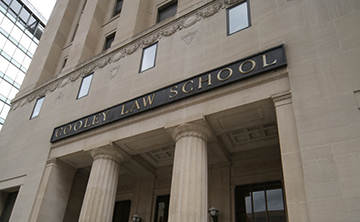The drop in law school applications during the past three years has had a profound impact on enrollment, according to a new study by The National Jurist.
Law school enrollment has dropped by an average of 99 students per school from 2010-2011 to 2013-2014, with only 16 schools enjoying an increase in students.
Eighteen law schools saw enrollment drop by more than 30 percent, led by University of La Verne (down 66.2 percent) and Thomas M. Cooley Law School (down 40.6 percent). Cooley Law School, with five campuses in Michigan and Florida, dropped from 3,931 students in 2010-2011 to 2,334 students in 2013-2014, the single largest drop in raw numbers.
“Cooley, like most, if not all law schools has experienced a downturn in applications and enrollment,” said Paul Zelenski, Associate Dean of Enrollment and Student Services at Cooley Law School. “Almost four years ago Cooley anticipated this downturn, so the current situation was not a surprise.”
Zelenski said the economic downturn and negative attitudes toward the legal profession have contributed to the decline in enrollment.
“An issue that frequently comes up by the vocal minority is student debt, which I can completely appreciate,” Zelenski said. “What has not been a part of the conversation is that more students are coming to law school with more debt from their previous education than ever before.”
New York Law School, which was battered by a critical New York Times article in 2011, has seen enrollment drop from 1,923 to 1,179, a 38.7 percent decline.
The National Jurist compared numbers for the 2010-2011 academic year from the American Bar Association’s Official Guide to Law Schools with 2013-2014 data from law schools’ most recent ABA 509 reports. The ABA now requires law schools to post detailed information on their websites in January of each year. At press time, The National Jurist was able to compare data for 196 law schools. The median law school saw enrollment drop 10.8 percent.
University of La Verne saw a dramatic drop in enrollment when it lost ABA accreditation in 2011. It quickly regained provisional approval, but enrollment numbers have not rebounded.
Other schools with the largest decline in raw numbers include Florida Coastal School of Law (from 1,742 to 1,279), University of the Pacific, McGeorge School of Law (1,026 to 632), and Seton Hall University (1,053 to 688).
In July, Seton Hall University announced it might eliminate all junior faculty positions — seven in all — after the 2013-2014 academic year. The faculty also approved a ten percent reduction in their salaries.
“Because of the dramatic drop in interest in legal education, all schools must make decisions about the size and quality of enrollment,” the school said in a statement.
Zelenski said Cooley Law School has not made any adjustments to curriculum or faculty, and has added new programs to try to entice new students.
“Cooley has been active on the recruitment scene by adding new programs and events to attract students when the market recovers,” he said. “We are emphasizing the value and versatility of the degree and encourag[ing] people to think beyond the here and now; instead to have enough foresight to think three years ahead and beyond.”
Schools with the greatest enrollment gains include Charlotte School of Law, which rose from 812 to 1,410, after it received full ABA accreditation in 2011; Arizona Summit (724 to 927); and Barry University School of Law (717 to 787).
Zelenski said law schools need to continue to employ intelligent and well-qualified professors and provide facilities that are attractive to students, while finding ways to reduce the cost of a legal education.
“I think law school enrollment will recover, probably not to the level it once was, but with the current trend of fewer people enrolling in law school now, coupled with an aging profession, there will be a need for attorneys, not even accounting for the hundreds of other things you can do with a law degree,” he said.
25 law school’s with largest enrollment declines by percent
University of La Verne -66.2%
Cooley Law School -40.6%
Catholic University -39.5%
New York Law School -38.7%
University of Dayton -38.5%
Pacific McGeorge School of Law -38.4%
Widener University – Harrisburg -36.9%
University of New Hampshire -34.8%
Seton Hall University -34.7%
Liberty University -33.9%
Western New England University -33.3%
Case Western University -32.7%
Hamline University -32.7%
Ave Maria School of Law -31.8%
Appalachian School of Law -31.0%
Widener University – Delaware -30.5%
Vermont Law School -30.5%
Saint Louis University -30.2%
Duquesne University -29.7%
Pace University -29.3%
University of Tulsa -29.3%
Quinnipiac University -28.9%
George Mason University -28.9%
California Western School of Law -28.1%
University of Iowa -28.0%

